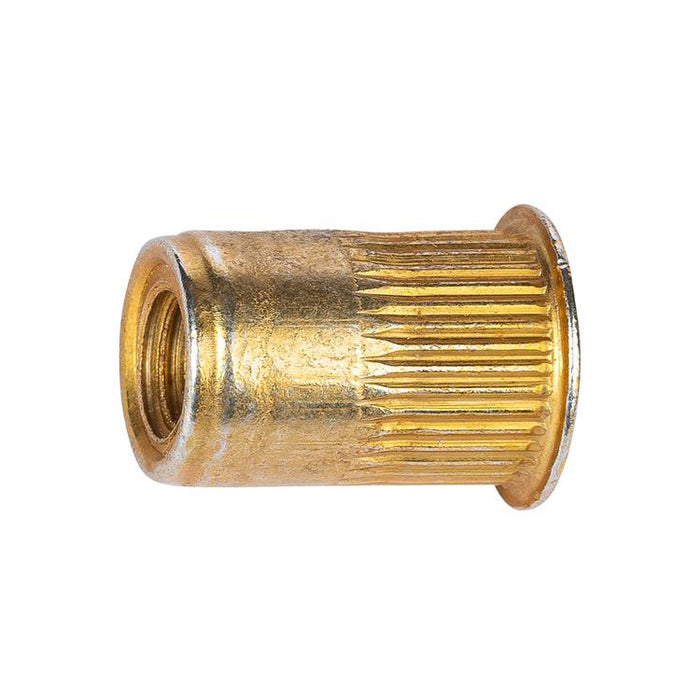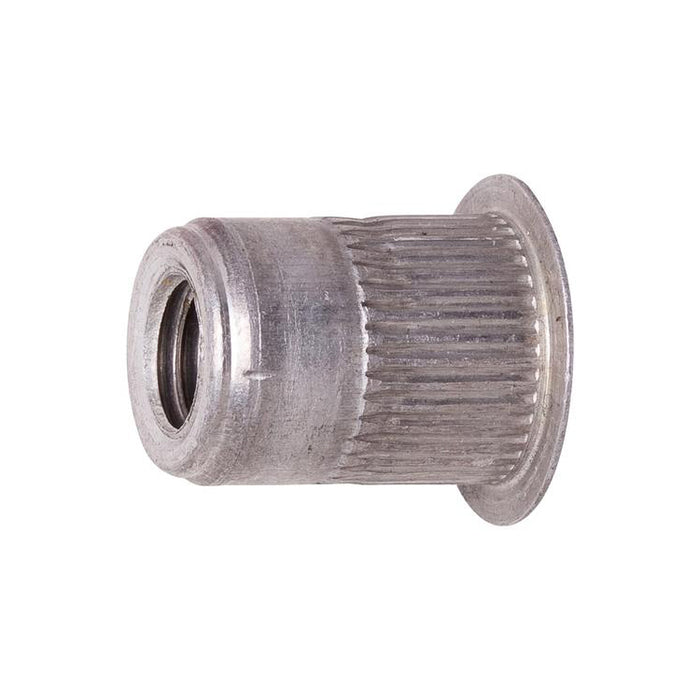Rivet Nuts AVK®
This rivet nut is a high precision AVK® insert.
Made in the USA, a threaded captive rivet nut to attach onto most surfaces for bolting applications. Easy to install via a punched or drilled hole, and a rivnut tool. These cold forged high precision quality fasteners from AVK® USA, are the ideal solution for load bearing applications. New to rivet nuts? Check the rivet nut page.
Rivet Nuts AVK - Aluminium - Knurled Body - Open End
54 From $29.70 Incl. GST(50 PCS)
Rivet Nut FAQ
What is a rivet nut?
Rivet nuts offer a secure threaded nut fastening solution in thin materials. Fundamentally rivet nuts are a combination of a nut and a rivet. They install like a rivet - which makes them great for one side or blind side installations and once installed you have an internal thread that is permanent - like a nut. A clever fastener that can be installed onto surfaces via a powered Rivet nut gun or a manual Rivet nut Tool for bolting purposes where conventional tapping is impractical as the parent material is thin. Ideal for punched or drilled holes that can be installed at any stage of the fabrication process even after final coat is applied. Aerobolt has a wide range of sizes including M3, M4, M5, M5, M6, M8, M10, M12 + select imperial sizes in a range of body types that include circular with numerous different body options, hex shape and a threaded stud options.
How do rivet nuts work?
Rivet nuts are particularly useful in applications where you need a strong thread in material that are way too thin to support a bolt on its own. These are the steps to install a rivet nut.
Step 1. Thread the rivet nut onto the mandrel of the tool, some tools assist in the loading process.
Step 2. Place the Rivet nut in the pre-drilled hole and activate tool to begin the installation process. Tool’s mandrel will pull up Rivet nut causing the body to compress and swell to seal and fill the hole.
Step 3. The Rivet nut has now bulged & created a lip on the blind side of the material, firmly interlocking onto the material.
Step 4. Rivet nut Tool will either automatically reverse out of the Rivet nut, or you will need to unthread the mandrel. Job well done!
Rivnut or Nutserts? They are all rivet nuts.
Rivnut or nutserts are different trademark or registered words that refer to "rivet nut", which is the generic term for these fastening components. Words can be trademarked for brand marketing purposes and sometimes these transcend to everyday language. Popular brand lingo like Nutsert® by Stanley Engineered Fastening, or Rivnut® by Bollhoff are popular trademarks that are used in everyday language to describe the Rivet nut fastener.
Components of a Rivet nut.
Body: The main part of the Rivet nut is typically cylindrical and has an internal thread for a bolt or screw.
Flange: A wider rim at one end that prevents the Rivet nut from being pulled through the material.
Body Surface: Knurled or Smooth Shank: Depending on selection.
How are Rivet nuts installed?
Drill a Hole: First, a hole is drilled into the base material, slightly larger than the uncompressed diameter of the Rivet nut.
Insert the Rivet nut: The Rivet nut is placed into the hole, with the flange resting against the surface of the material.
Rivet nut Tool: (Rivet nut tool, Rivet nut gun or nut riveter) are used to pull up the Rivet nut while pushing against its flange.
Rivet nut Installation Process: The action collapses and deforms the shank of the Rivet nut, causing it to bulge out and grip the backside of the material. This creates a secure hold, even in thin materials. Once installed, the Rivet nut provides a durable, threaded hole that can accept machine screws or bolts, allowing you to attach other components.
How do you install a Rivet nut without a tool?
This can be tricky if you are not handy, there are many online videos that show how this is done. At Aerobolt we recommend a Rivet nut tool for a professional finish.
How do you remove a Rivet nut?
Rivet nut removal is not straight forward even with the right tools as it could damage the parent surface. This requires the destruction of the Rivet nut, and the best method is to drill it. You will need, a drill, drill bit, long nose pliers, & safety accessories such as glasses and gloves.
Steps: Use your safety glass & gloves before starting the drilling process. Place the drill bit inside the Rivet nut centre and drill the body at a low but steady speed. Once drilling is completed, pull the Rivet nut off with your long nose pliers.
Types of Rivet nuts.
Aerobolt has a comprehensive range of Rivet nut, covering a wide range of body types and shapes.
Open-End Rivet nut: Allow bolts or machine screws to pass completely through.
Closed-End Rivet nut: Seal the backside, preventing liquids or debris from entering.
Knurled Rivet nut: Have ridges on the shank for extra grip, these are Aerobolt’s #1 nutsert.
Smooth body Rivet nut: Suitable for low torque applications in thin sheet metals.
Hex shape Rivet nut; Hexagonal shape rivet nut for superior resistance to unscrewing.
Threaded Studs; A nutserts with a protruding thread rather than an internal threaded opening.
Rivet nut Applications.
Rivet nuts are commonly used in industries like automotive, aerospace, and construction for attaching brackets, mounting components, or securing panels. They are ideal for repair work or situations where you cannot access the backside of the material (blind installations).
How strong are Rivet nuts?
The strength of Rivet nuts (rivet nuts or threaded inserts) depends on several factors, including their material, size, and the material into which they are installed. Here is an overview of their strength characteristics:
Factors Affecting Rivet nut Strength
1. Material of the Rivet nut
Steel Rivet nuts: Provide the highest strength and are ideal for heavy-duty applications.
Stainless Steel Rivet nuts: Offer excellent strength and corrosion resistance, suitable for harsh environments.
Aluminium Rivet nuts: Lighter and less strong than steel, but still sufficient for many lightweight applications.
2. Thread Size
Larger Rivet nuts can accommodate larger bolts, which can handle higher loads.
The thread engagement also affects the pull-out and shear strength.
3. Installation Material
The holding strength of a Rivet nut depends on the thickness and type of material into which it is installed. For example:
Steel or Aluminium Sheets: Provide higher clamping and shear strength.
Plastic or Thin Sheets: May limit strength due to deformation under load.
4. Installation Quality
Proper installation ensures a secure grip, preventing spin-out or pull-out under load.
Over-tightening can damage the material or weaken the connection.
Strength Metrics
Rivet nuts are typically rated for two key forces:
Pull-Out Strength:
The force required to pull the Rivet nut out of the base material.
Stronger materials and thicker sheets increase pull-out resistance.
Example: A steel M6 Rivet nut in a 1.5mm steel sheet can withstand 300-500 pounds (136-227 kg) of pull-out force, depending on the brand and installation quality.
Shear Strength:
The force that the bolt or screw can resist parallel to the surface.
This depends on the bolt grade, Rivet nut material, and thread engagement.
Example: A steel M8 Rivet nut in a similar setup might handle shear forces of 700-1000 pounds (318-454 kg).
Applications and Load Considerations
Rivet nuts are generally strong enough for: Mounting brackets, panels, or hardware.
Securing parts in automotive, aerospace, or marine industries.
Applications requiring reliable performance under moderate loads.
However, for extreme loads, alternatives like weld nuts or high-strength fasteners might be more appropriate.

